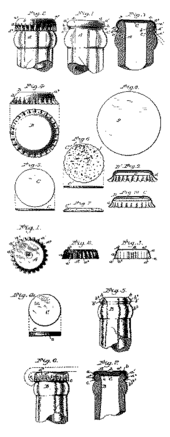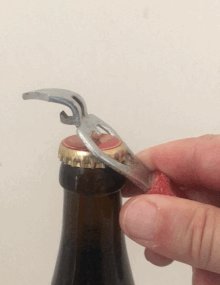Bottle caps
A crown cork , crown cork or crown cork (in Austrian usage : beer capsule ) is a circular piece of sheet metal , the edge of which is bent into a crown and which is provided with a sealing insert made of polyethylene (PE).
The crown cap is used to seal drinks bottles airtight and tasteless. To open a bottle closed in this way , a tool is usually required, usually a bottle opener . With suitable bottles, however, the crown cork ( twist-off crown cork or twist off ) can also be unscrewed by hand, as with a screw cap.
History of origin
In 1892 the inventor William Painter (1838–1906) from Baltimore applied for a patent for the crown cap . He called his invention "Crown Cork" - crown corks.
The crown cork was initially used in beer bottles in the USA and largely replaced the swing top , as it is much cheaper to manufacture and the closing process is much faster. Due to the success of this product, Painter founded the Crown Cork and Seal Company in April 1893 , which today no longer makes crown corks.
It is useful that sparkling wines ( champagne , sparkling wine ) with classic bottle fermentation are initially closed with crown corks ( bidule ) during the fermentation phase . After freezing the bottle neck, the crown cap is opened automatically and the frozen yeast plug is "shot out" by the internal pressure of the carbon dioxide (dégorgement). Only then is the bottle closed with the usual champagne cork .
Technical structure and manufacture
For glass bottles whose mouthpieces are manufactured in Europe according to the DIN EN ISO 12821 (mouthpiece 26 H 180) or 12822 (mouthpiece 26 H 126) standard, the standard for the appropriate crown corks is DIN EN 17177 . The dimensions (in mm) are listed below:
| in mm | Tolerance in mm | |
|---|---|---|
| Inside diameter: | 26.75 | + 0.15 / -0.00 |
| Height: | 6.00 | ± 0.15 |
| Outer diameter: | 32.10 | ± 0.20 |
| Radius: | 16.05 | ± 0.25 |
| Sheet thickness: | 0.20 | ± 0.02 |
The crown cap common today has 21 points; originally it was 24 points. One reason for the change was to reduce the bottle neck diameter. In addition, the odd number of prongs makes a significant contribution to the process-reliable feeding of the crown corks to the closer element. Crown corks with an even number of prongs tilt more easily because two prongs are exactly opposite each other. The metal sheets ( tinned tinplate or chrome sheets according to Euro standard EN 10.202 ) for the crown corks can be printed on both sides, transparent or colored as additional protection against corrosion and a primer for the printing inks using the offset process according to customer requirements. In most cases, the factory also prints its logo - the marginal sign - so that it can be seen on the side of the crown cap on the spikes. In addition, colored markings for "collection campaigns" can be made on the inside of the crown corks. The 21-point crown corks are then punched out of these tablets on special double-acting presses (with two rams that run into one another), which usually process the entire tablet. The weight of crown caps is approx. 2.2 grams.
poetry
In a second operation, the seal is extruded from PE - granules used (with a circular sealing bead) for the air- and pressure-tight sealing to allow the bottles. Seals made of pressed cork were still used until the end of the 1980s and PVC seals until the end of the 1990s .
Manufacturer
In Germany, crown corks are currently (as of 2017) from the Delmenhorster Cork Factory (edge mark DKF), Rauh GmbH & Co. Blechwarenfabrikations-KG in Küps (edge mark RRK), Helmut Brüninghaus GmbH & Co. KG in Versmold (edge mark HB) and Blechwarenfabrik Limburg GmbH (border mark BL). In Switzerland, the last producer (Ernst AG Verpackungen in Küsnacht ) stopped production of crown corks in 2007 .
variants
With a special design of the bottle mouth similar to a thread , it is possible to use a crown cap as a screw cap so that it can be opened and closed again without a bottle opener ("twist top" or "twist off"). Due to the high forces involved in the closing process, this screw cap is only used for disposable bottles.
The principle can be found in French, South African, Australian, Southeast Asian ( San Miguel ), US and rarely in Austrian and Swiss beer bottles - for example Zipfer Sparkling, Ottakringer cool blondes, Eichhof (CH) and 0.3 l one-way bottles from the Stiegl brewery in Salzburg .
Another innovation is the so-called freshness closure developed by the Austrian Ottakringer brewery , in which a plastic lip is worked into the crown cap that extends into the neck of the bottle. According to the manufacturer, this should result in lower carbon dioxide emissions during storage. Another marketing aspect should be the popping noise that occurs when the bottle is opened.
The company D'Angelico & Dietrich Acoustic Consult has been granted two international patents with which the sound can be changed when opening carbonated beverages with crown corks. The first patent enables - depending on the version - the creation of a champagne-like popping effect or a whistling sound. The second patent allows grinding or cracking noises. The sounds were named Champagne, Fresh and Crush and are distributed by Credit Suisse's Patent Invest Fund for global marketing.

A variant of the crown cap is the so-called pull tab. This - jagged - closure can be opened without tools by pulling the integrated flap with your fingers.
Open, reclose
“ Bottle opener ” means differently designed tools for opening beverage bottles.
As a rule, a bottle opener hooks under a few prongs on one side and lifts the crown cap off starting on one side. Depending on the type of opener and perspective, hooking takes place under the rear or front of the closure. Another part of the J-shaped or D-shaped opening shallow opener is supported on the top of the closure and usually dents and kinks it when the hand pushes the opener down or lifts it up.
By carefully and gently lifting the crown cap at several points on its circumference, the bending of the sheet metal part can be kept so low that a reclosing z. B. is possible in one fell swoop. The lid, which only holds with little force, does not sufficiently maintain the possible internal pressure, but prevents dirt from falling in or insects flying in. It can be reopened without tools.
There is a beer opener made of chrome-plated sheet metal, the lever handle of which is sufficiently large and flat and lined with an approximately 3 mm thick rubber seal. On the tapered long sides, the sheet metal is folded in by 90 ° and about 75 ° so that these sheet metal strips can engage under the bead of the bottle neck, which otherwise holds the crown cork prongs, and press the rubber tightly on when the opener is pushed open tightly from one side becomes.
With sufficient skill, strength and practice, a number of other methods can be used to open the crown cap: The edge on a horizontally lying end-grain wood surface on top of a fence post and knocking over it from above. A suitably hard piece of square timber, the back of a knife or even a tightly folded piece of A4 writing paper, bottle and makeshift opener with both hands. If you use the closing opening of a mounted door frame, the bottle must be tilted so that some beverage loss is practically inevitable.
Term "sleepyheads"
In the area of filling and production, the crown cork closures are also referred to as sleepyheads . The term originated at the end of the 19th century because at that time the sleepyheads had a jagged cut, similar to that of crown corks. Especially in the area of production control, one still speaks of the “sleepyhead control” today. There are different technical processes for quality assurance, with the help of which the correct fit of crown corks on the bottle is checked:
- Checking regular / even tension on the top of the sleeping hats
- With the help of acoustic signals, the sleepyhead is made to vibrate , whereby the vibration behavior provides information about the correct fit.
- Optical control with the help of a camera, with a computer checking the symmetrical fit
- Control by means of a crown cap template (principle of a gauge ), which has at least two diameters: The 28.8 mm diameter must fit loosely over the crown cap without applying force; With a diameter of 28.6 mm, the crown cap must get stuck.
Other uses

There are also uses for crown corks that go beyond bottle caps.
- They are well suited for a variant of the skill game English football practiced by children and young people .
- In art and music lessons at elementary and special schools, they are used to make rattle and sound instruments .
- In countries of the “third world”, crown caps are used, among other things, as game pieces in checkers . The black figures show the outside, the white the inside; in both variants they can easily be stacked to form a lady .
- In the same way, crown corks can be used for mills or other games in which two different colored game pieces are in use.
- One type of soap holder has a bottle cap pushed into a bar of soap , which is then held in place by a magnet .
- Crown corks are enjoying growing popularity with collectors . The value varies and depends, depending on the type of collection, on how old or how rare the crown cap is, and whether it is brand new or removed from a bottle. For example, a free online catalog can be found on Colnect.
- In the meantime, there are numerous approaches to further processing the crown corks, for example into jewelry or decorative objects, due to the design diversity of bottle caps.
- In terms of waste, crown corks are a recyclable raw material. In Germany, therefore, separate disposal from residual waste is provided as packaging in accordance with the green dot , without the crown cork having to bear the corresponding license mark . There are also various charitable collection campaigns for crown caps in Germany, which donate the proceeds from the sale of the raw material.
- Hobby artists use bottle caps as a material for works of art of various designs.
- Crown corks can serve as a force-distributing supplement for nailing roofing felt , tarpaulin or sheet metal.
- Nailed with the prongs outwards, you can create non-slip feet for boxes or a scratching tool.
- You can use crown caps as egg cups if you put them inside out.
- Anglers can also use the piece of tinplate: with the smooth surface attached to a piece of wood, the crown cork offers the perfect grip for descaling the fish.
Web links
- Country list of the crown cap catalog at Colnect
- Overview of marginal characters at Davide Mascherini , status: January 24, 2013
- This is how crown caps are made , Youtube video
Individual evidence
- ↑ Patent No. 468,258 with the 24-tooth crown from February 2, 1892 , from Google patents .
- ↑ Standard DIN EN ISO 12821 glass packaging - crown mouthpiece 26 H 180 - dimensions (ISO 12821: 2019)
- ↑ Standard DIN EN ISO 12822 glass packaging - crown mouthpiece 26 H 126 - dimensions (ISO 12822: 2020)
- ↑ a b Standard DIN EN 17177: 2020-01 Glass packaging - Crown closure - Crown closure with a diameter of 26 mm and a height of 6 mm (EN 17177: 2019)
- ↑ Bottle cap collection campaign Official website , June 21, 2018
- ↑ This woman from the Unna district collects bottle caps for a good cause. Unna24, December 2, 2017, accessed June 21, 2018 .





